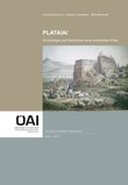Explore

Plataiai
Plataiai im südwestlichen Boiotien ist vor allem durch die Ereignisse im Jahr 479 v. Chr. bekannt. Der Sieg der Griechen über die persische Armee hat gemeinsam mit Salamis den Lauf der europäischen Geschichte signifikant beeinflusst und war oftmals Gegenstand neuzeitlicher und moderner wissenschaftlicher Betrachtung. Die antike Polis, die der Schlacht ihren Namen gegeben hat, ist von der historischen, besonders aber von der archäologischen Forschung jedoch vergleichsweise vernachlässigt worden. Um das auszugleichen, hat das Plataiai-Projekt im Jahr 1996 mit der Erforschung der ausgedehnten Ruinenstätte begonnen. Die in der Laufzeit des Projekts erzielten Ergebnisse ermöglichen es, die Besiedlungsgeschichte des Platzes über eine Zeit von beinahe 7 Jahrtausenden nachzuzeichnen. In der relativen Sicherheitslage von Plataiai am Fuß des Kithairon beginnt kleinmaßstäbliche Siedlungstätigkeit im Mittelneolithikum und setzt sich beinahe ungebrochen bis in historische Zeit fort. Im Werdeprozess des klassischen Hellas entwickelt sich auch Plataiai zur unabhängigen Polis. Ihre Verstrickung in die Machtkämpfe der späten Archaik und der Klassik macht die Stadt zum Brennpunkt historischer Ereignisse auch über die Perserkriege hinaus - nicht immer zu ihrem Vorteil. Im Spannungsfeld zwischen Sparta, Athen und Theben erleidet Plataiai zweimal Zerstörung und Entvölkerung. Erst die Verschiebung der politischen und strategischen Gewichte durch Philipp II und Alexander den Großen sichert der Stadt die weitere Existenz, die im Hellenismus und während der Kaiserzeit relativ ungestört verläuft. Das 6., 5. und frühere 4. Jh. sind am Platz vor allem durch oberflächige Keramikfunde und die früheste bekannte Befestigung von Plataiai dokumentiert. Kleinräumige Grabungen haben ein kultisch konnotiertes Materialdepot aus dem 6. Jh. angeschnitten, dazu Bebauung aus der Zeit. Die endklassisch-hellenistische Siedlungsgeschichte der Stadt spiegelt sich in einem groß angelegten Ausbau der Stadt, mit einem ausgedehnten Mauerring und einer Binnengliederung auf orthogonalem Grundriss. Geophysikalische Prospektion dokumentiert den Staßenraster, die Agora, das Heiligtum der Hera, ein Dionysosheiligtum und andere öffentliche Bauten ebenso, wie eine ausgedehnte private Binnenbebauung. Gerade letztere liefert auch Anhaltspunkte dafür, dass sich in Plataiai einige reiche Familien etablieren konnten, die ihren sozialen und politischen Status auch mittels großer Stadthäuser ausdrückten. Das Oberflächensurvey liefert weitere signifikante Daten zur Siedlungsgeschichte und zur Besiedlungsdichte der Stadt. Die Spätantike bringt eine scharfe Zäsur. Zunehmende militärische Bedrohung veranlasst Plataiai zur Errichtung einer Notfallsbefestigung. Doch belegen mehrere Kirchen gemeinsam mit der Erwähnung Plataiais als Bischofssitz und einer Notiz bei Procopius die weitere Existenz der städtischen Siedlung zumindest bis in die Regierungszeit Iustinians. Im Frühmittelalter könnte der Platz aufgegeben worden sein, doch belegt Oberflächenkeramik eine (erneute?) Besiedlung ab dem 11. Jh. Das neuzeitliche Dorf Kokla trägt seit den 1920er Jahren den antiken Namen Plataies und führt damit die Siedlungstradition von Plataiai ungebrochen bis in die Jetztzeit fort.
This book is included in DOAB.
Why read this book? Have your say.
You must be logged in to comment.
